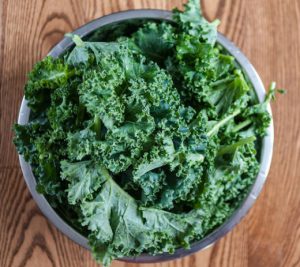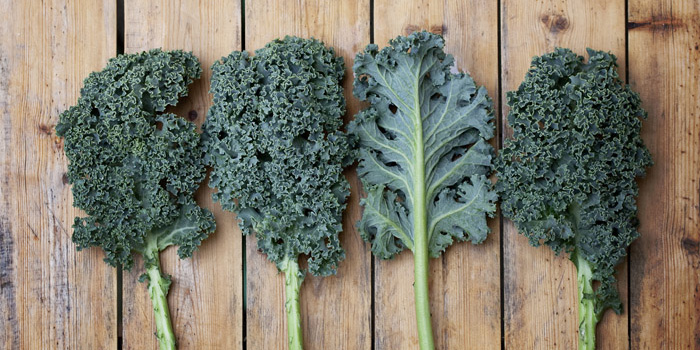 I love the color green, and I love green food! I can’t get enough kale, spinach, and broccoli. I used to hate Brussels sprouts, but they’re now in my weekly menu rotation. In the warmer months, I forgo tortillas and bread and use collard greens to make wraps and sandwiches. If I go more than a few days without a giant salad, I find myself craving romaine and cabbage.
I love the color green, and I love green food! I can’t get enough kale, spinach, and broccoli. I used to hate Brussels sprouts, but they’re now in my weekly menu rotation. In the warmer months, I forgo tortillas and bread and use collard greens to make wraps and sandwiches. If I go more than a few days without a giant salad, I find myself craving romaine and cabbage.
I know that not everyone loves greens as much as I do. In fact, the one thing that’s most lacking in Americans’ diets is the leafy green. Most Americans only eat greens once or twice a week, and when they do, it’s usually iceberg lettuce. And even then, it’s usually on top of a burger.
Leafy greens are packed with nutrients, and they should be consumed every day. Where else are you going to find calcium, magnesium, iron, potassium, phosphorous, and zinc, as well as Vitamins A, C, E and K in one tidy package? Leafy greens are also full of fiber, folic acid, chlorophyll, and many, many other micronutrients and phytochemicals.
There are many reasons to eat your greens, but here are my top ten:
Strong Bones – Forget the cows’ milk, you really need leafy greens for strong bones! Minerals come from the soil that our food is grown in. Leafy greens pull minerals like calcium in through their roots and disseminate the nutrients through their leaves. The high levels of Vitamin K in greens also help to keep bones strong. Spinach, Swiss chard, and beet greens don’t give up their calcium easily though, due to a compound called oxalic acid, so make sure you’re eating a wide variety of green leafies.
Bowel and Intestinal Health – I know that people don’t usually like to talk about their colons, but keeping them healthy is extremely important. The foliate that’s found in leafy greens has been shown to reduce the risk of colon polyps, and the high amounts of dietary fiber found in green veggies helps to keep things moving smoothly through the intestines. A healthy gut also means a health immune system.
Healthy Intestinal Flora – Speaking of intestines, our bodies need beneficial bacteria in order to stay healthy, and these bacteria, or flora, live in our intestines. An unhealthy diet of sugar and junk food, can wipe them out, as can taking antibiotics, allowing bad bacteria to take over. Greens contain compounds that protect the body from the bad bacteria, and they’re known to feed the healthy flora, as well.
Strengthened Immune System – The many nutrients in leafy greens help strengthen the immune system and prevent inflammatory diseases. Beta-carotene is converted into Vitamin A, which improves immune function. We all know that Vitamin C is good for the immune system, and it’s found in abundance in green veggies. Vitamin E is a powerful antioxidant that helps the body fight off infection. Greens also help clear the body of toxins, making it easier to fight of infections and diseases.
Cancer Prevention – Because of the high content of antioxidants, greens are among the best foods for preventing cancer. Studies have shown that eating two or three servings of leafy greens a week can help lower the risk of many types of cancers.
Heart Health – The same antioxidants that can prevent cancer, also work to keep the heart in tip-top shape. The calcium in leafy greens has been shown to lower blood pressure, as does the dietary fiber. Fiber also helps lower cholesterol. The Vitamin K found in green vegetables helps blood to clot, and prevents arteries from calcifying. The folate found in green vegetables helps to break down homocysteine, an amino acid in the blood that is know to increase heart-disease risk.
Improved Circulation – Humans used to have the ability to know what parts of the body foods were good for just by looking at them. I like to demonstrate this my health coaching clients by showing them a few leaves from purple kale or red chard. The red veins running through the leaves mimic veins of blood running throughout the human body. The compounds found in greens help with improved blood circulation as well as blood purification.
Blood Sugar Regulation – Because of their high magnesium content and low glycemic index, green veggies are can be very beneficial for regulating blood sugar, making them very beneficial to people with diabetes. Just one serving of leafy greens a day has been shown to lower the risk of developing diabetes.
Eye Health – The beta-carotene, lutein, and zeaxanthin found in leafy greens play an active roll in protecting the eye. Together, they help filter high-energy light that can lead to eye damage and they reduce the discomfort caused by sun glare. These nutrients also protect against both cataracts and age-related macular degeneration, a major cause of blindness in the elderly.
Improved Energy and Mood – The vegetables we eat can take on the properties of how they are grown. Root vegetables grown downward into the soil, and they can have a grounding effect on our mood when we eat them. Leafy greens grow upward, facing the sun, and they can lift our sprits upwards, giving us light, flexible energy. This energy can also help lift one’s mood, and even help eliminate mild depression. The nutrients found in leafy greens also help. Folate helps with the brain’s production of serotonin, which can improve mood and fight depression.
Leafy greens can also improve liver, gall bladder and kidney function; clean congestion and reduce mucus; help maintain weight loss; protect the skin, and prevent birth defects, and they have many more benefits that I haven’t listed here. I recommend eating green veggies at least once a day!
Reprinted with permission from Dianne’s Vegan Kitchen
